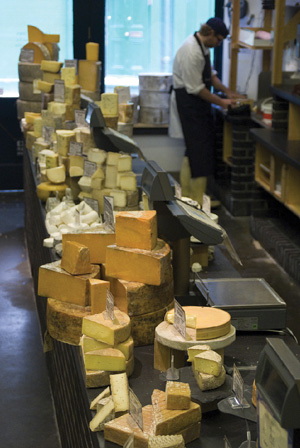During a recent trip to London, a friend served me a pair of outstanding Vouvrays from Domaine Huet. Both were demi–secs from Le Haut–Lieu, and both were from the 2002 vintage. One was made from ungrafted vines.


Afterwards, I called up Noël Pinguet, winemaker and co–owner of Domaine Huet, to ask him about these wines. He said that he farms about three–quarters of an acre of ungrafted vines in Le Haut–Lieu, planted about ten years ago, and that 2002 was the first vintage in which they bottled the ungrafted vines separately. “There’s usually less alcohol in the ungrafted wine, and the aromas are a little finer,” said Pinguet. “The wine from grafted vines has more puissance, but there’s more finesse in the ungrafted one. They’re of different styles and different characters.”
A couple of days later, I thought about those Vouvrays again while tasting cheese in the maturing cellars of Neal’s Yard Dairy, the UK’s source of artisanal farmhouse cheeses. Bronwen Percival, cheese buyer for Neal’s Yard Dairy, showed me around the premises housed under London’s railway arches, and we sampled a wide array of cheeses in various stages of maturation. Eventually we reached the cellar where they keep the blues, and proceeded to undertake a head–to–head comparison between Colston Bassett, surely the finest Stilton in existence, and Stichelton.
All Stilton is made entirely from pasteurized milk and synthetic rennet, as required by the Stilton Cheesemakers Association since 1989. In an effort to recapture the character and flavors that made Stilton famous in the first place, cheesemaker Joe Schneider and Randolph Hodgson, owner of Neal’s Yard Dairy, have teamed up to make an unpasteurized blue cheese using the original methods. Since they can’t call it Stilton, it’s called Stichelton, which is an old name for the village of Stilton.
What surprised me was not so much that these two cheeses were different, but how much the distinctions between them reminded me of the differences between the two wines from Huet. The Colston Bassett Stilton has always been a personal favorite of mine, and while it was excellent, it felt as if it was working within a more restricted palette of flavors. The Stichelton, in comparison, demonstrated both greater complexity and greater dimension of flavor, much like Huet’s ungrafted Vouvray. This isn’t unusual, according to the experts. “All things being equal, I would say that unpasteurized cheeses have more complex and longer–lasting flavor,” says Percival. “By comparison, pasteurized cheeses often taste very straight–line, lactic, clean and safe.” She notes that Hodgson often describes the difference as being “like stereo vs. mono.”
It’s not true that ungrafted vines always produce better wine, or that unpasteurized cheese is always better than pasteurized cheese. In both cases, there are many other variables that contribute to the characters of the resulting products. But these tastings reminded me how much each process fundamentally alters its base material. When a vine is grafted onto a completely different plant, it changes the way that it processes sugars, which is why grafted vines generally produce wines of higher alcohol and riper fruit than their ungrafted counterparts. With cheese, the original bacteria that is responsible for developing flavors is destroyed, and a much smaller set of cultures is added in its place. “Effectively, in a pasteurized cheese, you’ve wiped out all the native lactic acid bacteria in the milk and replaced them with starter cultures containing just five to ten strains of bacteria,” says Percival. Neither of these things necessarily produces an inferior product, and certainly great wines are made from grafted vines, great cheeses from pasteurized milk. But in the interests of authenticity and originality, if it were possible to avoid these actions, wouldn’t that be preferable?
In modern times, the grafting of vines is necessary to protect them from phylloxera, and outside of a few naturally protected places, most regions of the world wouldn’t even be able to make wine if their vines weren’t grafted. It has to be done. It’s true that a handful of estates such as Huet are conducting small experiments with ungrafted vines, and occasionally we are fortunate to be able to taste them, but in the end the story is almost always the same—it’s a losing battle. “Phylloxera is always present,” says Pinguet. “Even now, some of those vines [in Le Haut–Lieu] are already dying from phylloxera.”
In the case of cheese, however, pasteurization is an option, not a necessity. This is not to say that it isn’t done for very good reasons. If the milk isn’t impeccably clean, pasteurization helps to prevent problems relating to both health and flavor. It’s also a way to ensure a certain quality standard, especially for those who are just starting out. “If a cheesemaker doesn’t know what he or she is doing, it’s often easier to attain a consistent and edible result using pasteurization as a tool,” says Percival. With Stilton, though, there are outstanding producers such as Colston Bassett who are pasteurizing their cheeses because the regulations insist that they do so, not because their milk isn’t clean (and certainly not because they don’t know what they are doing). In that case, it’s just a shame. If they were allowed to use raw milk, just think what their cheeses might be like. Oh wait, we already know—Stichelton.
This story was featured in W&S October 2009.
Author of the much-anticipated Champagne, an obsessively detailed guide to the region and its wines, he’s been a part-time resident of Champagne since 2006, where he reports for his site, champagneguide.net. A former tasting coordinator and critic for this magazine, he last wrote for W&S on sustainable farming in Champagne in our December 2016 issue.
This story appears in the print issue of October 2009.
Like what you read? Subscribe today.















